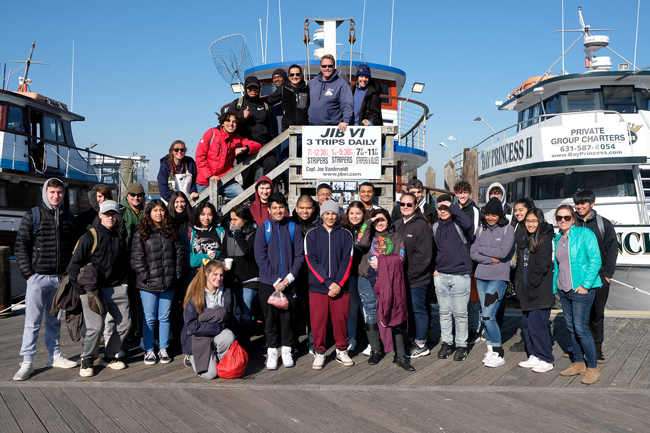
Brentwood and Smithtown West students spent the day bass fishing for Bass as part of “No Child or Teacher Left Inside.” This is one of six "2019 Marine Small Grants Projects" provided via New York State Department of Environmental Conservation (NYSDEC) and New York Sea Grant (NYSG). In addition to having helped educate students, these grants have enhanced fishing access for people of all abilities, and improved fisheries data collection to enable more New Yorkers to enjoy the state’s diverse marine resources. Credit: Rebecca Grella
— By Dr. Rebecca Grella
Stony Brook, NY, February 8, 2020 - Recognizing that there is an imminent need to train the next generation of conservation minded citizens, “No Child or Teacher Left Inside” focuses on engaging Long Island high school students and teachers in studies of pressing environmental issues impacting Long Island salt marshes. The project was led by Rebecca Grella, Ph.D., Brentwood Union Free School District and Joanne Figueiredo, Ph.D., Smithtown Central School District.
In this NYSDEC / NYSG-sponsored project, students and teachers from Smithtown West and Brentwood High School have suited up to not only restore salt marshes, but also develop solutions on how to preserve the marsh. With support through the sale of New York State’s Marine and Coastal District license plate, our program has encouraged students and teachers to ask questions about their marine environment.
By participating in the “No Child or Teacher Left Inside” program, students and teachers are engaged in research that documents real-world problems using real science. The collaboration between Brentwood and Smithtown school districts models the collaborative nature of science. The program implements Next Generation Science Standards by allowing students to use remote sensing to assess marshes and fisheries and utilizes real-time data from the National Oceanic and Atmospheric Administration (NOAA) to understand algal blooms. Most importantly, students interact with nature by taking a role in the future of our planet as we introduce them to real world issues.
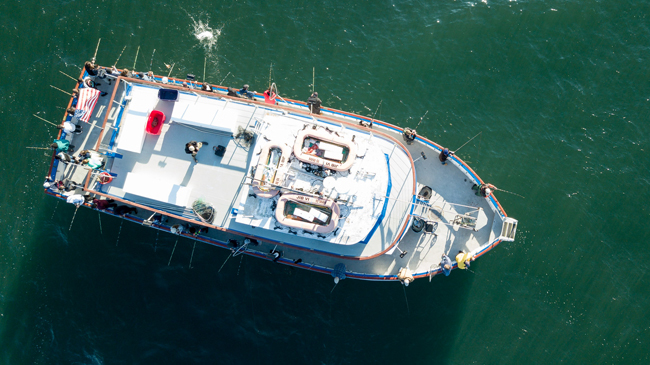
“Our goal is to raise awareness of the delicate aquatic ecosystem and interact with nature,” said project co-lead Rebecca Grella. She and her class went out fishing on a boat chartered by JIB VI Captree Fishing, which sails out of New York's Captree State Park. Credit: Rebecca Grella
Research questions are not the only focus for the efforts of “No Child or Teacher Left Inside,” as education is also imperative. Last year marked the first year of training a cohort of teachers from Brentwood School District to engage them in hands on investigation of salt marsh ecosystems. Training teachers and students is a critical component of our program. Thus, our program engages high school students and teachers directly with scientists at Stony Brook University (SBU) as a means to provide cutting edge STEM (science, technology, engineering, and mathematics) curricula.
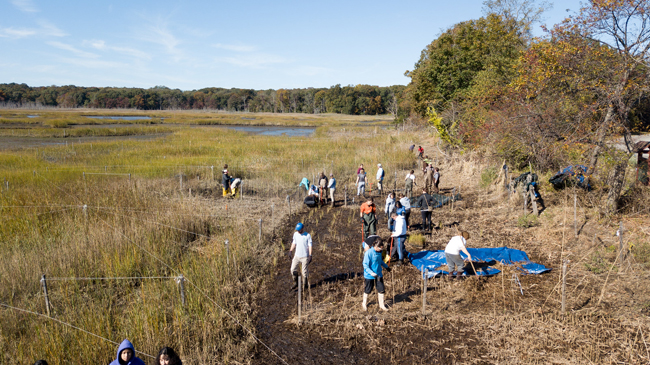
Brentwood High School students replanting the salt marsh at Sunken Meadow State Park as part of a Long Island Sound Study stewardship effort. Credit: Rebecca Grella
For 10 years, Brentwood High School students have been working at the Flax Pond Marine Station (Flax Pond) in Old Field, New York assessing the impacts of nitrogen loading in this salt marsh ecosystem. The foundation of the work begins at SBU’s Flax Pond. At Flax, students explore issues ranging from invasive species to nitrogen loading. Over the years, these projects have garnered students national recognition in premiere STEM competitions. More recently, with increased attention on climate change, our focus has been on salt marsh restoration as marshes are powerhouses at sequestering carbon. Our current project assesses a novel method of creating a substrate in areas where there are high erosion rates as a means to plant more marsh grass. The research focus is to use natural compounds to develop a “glue” for restorative purposes.
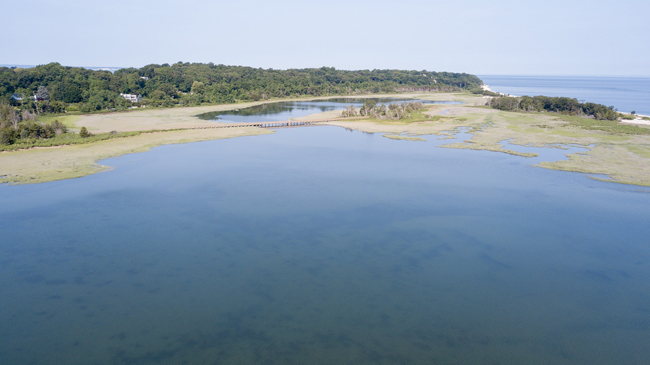
An aerial view of Flax Pond. For a decade, Brentwood High School students have been working with Stony Brook University researchers to determine the impacts of nitrogen loading in this salt marsh ecosystem. Credit: Rebecca Grella
Our recent restorative work involved a collaboration with the Long Island Sound Study (LISS). In October, students were involved in planting over 1,000 Spartina at Sunken Meadow State Park. Through our efforts with LISS, we have helped create materials to educate the public about natural wetlands and look forward to showcasing these efforts to the public. These experiences coupled with laboratory efforts led Brentwood School District students to compete in the Samsung Solve for Tomorrow competition. The student research team investigates methods to curb salt marsh erosion using guar and Xanthan gum, naturally occurring food additives. The students of this project were recognized at state finalists and garnered $15,000 in prizes from Samsung. The students are now in the running for the $100,000 prize.
Students play a large role in the design and development of all aspects of programming materials for the project. Stay tuned for a video, podcast and materials to be showcased on social media, i.e. Twitter, Instagram, YouTube and Facebook.
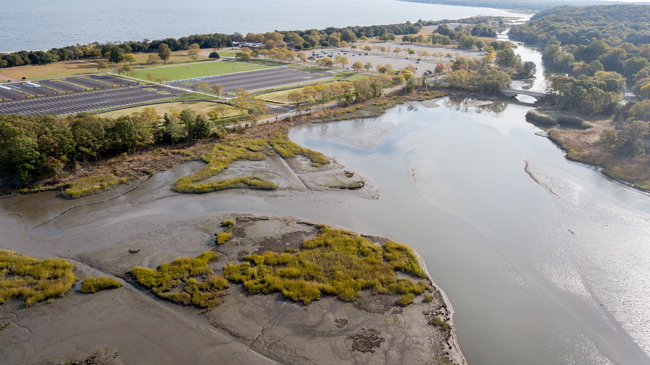
An aerial view of Sunken Meadow’s salt marshes. “When we are not in the lab you can find us ‘out in the field’ using STEM to solve Long Island’s salt marsh loss,” says Grella. “We are doing our best to bring home a $100K prize for the school.” Credit: Rebecca Grella
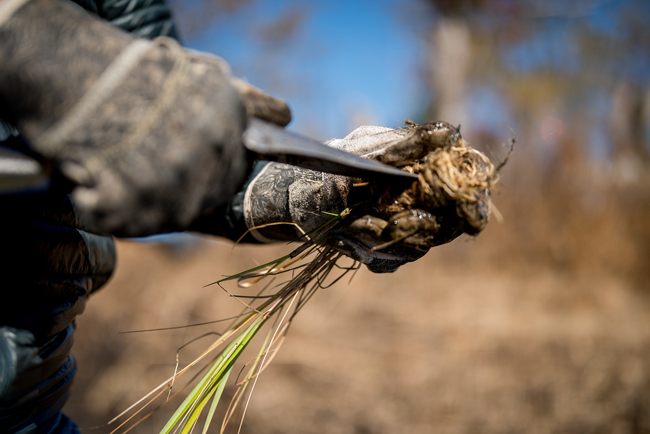
More Info: Marine Small Grants
This project was supported by a partnership between New York Sea Grant, the New York State Department of Environmental Conservation, and the Marine and Coastal District of New York Conservation, Education, and Research Grants Program.
Funding is supported from the Marine and Coastal District License Plate which is administered by the Marine and Coastal District of New York Conservation, Education and Research Board, and authorized through NYS Environmental Conservation Law Article 13, Title 5 Section 13-0503. Any opinions, findings, and conclusions or recommendations expressed in this publication are those of the authors(s) and do not necessarily reflect the views of New York State Department of Environmental Conservation, Stony Brook University or New York Sea Grant.
More Info: New York Sea Grant
New York Sea Grant (NYSG), a cooperative program of Cornell University
and the State University of New York (SUNY), is one of 34 university-based
programs under the National Oceanic and Atmospheric Administration’s
National Sea Grant College Program.
Since 1971, NYSG has represented a statewide network of integrated
research, education and extension services promoting coastal community
economic vitality, environmental sustainability and citizen awareness
and understanding about the State’s marine and Great Lakes resources.
Through NYSG’s efforts, the combined talents of university scientists
and extension specialists help develop and transfer science-based
information to many coastal user groups—businesses and industries,
federal, state and local government decision-makers and agency managers,
educators, the media and the interested public.
The program maintains Great Lakes offices at Cornell University, SUNY
Buffalo, SUNY Oswego and the Wayne County Cooperative Extension office
in Newark. In the State's marine waters, NYSG has offices at Stony Brook
University in Long Island, Brooklyn College and Cornell Cooperative
Extension in NYC and Kingston in the Hudson Valley.
For updates on Sea Grant activities: www.nyseagrant.org has RSS, Facebook, Twitter, and YouTube links. NYSG offers a free e-list sign up via www.nyseagrant.org/nycoastlines for its flagship publication, NY Coastlines/Currents, which is published quarterly. Our program also produces an occasional e-newsletter,"NOAA Sea Grant's Social Media Review," via its blog, www.nyseagrant.org/blog.